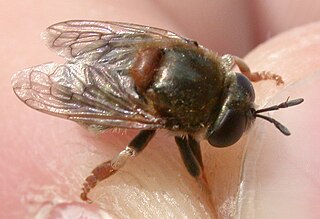
Hoverflies, also called flower flies or syrphids, make up the insect family Syrphidae. As their common name suggests, they are often seen hovering or nectaring at flowers; the adults of many species feed mainly on nectar and pollen, while the larvae (maggots) eat a wide range of foods. In some species, the larvae are saprotrophs, specifically detritivores, eating decaying plant and animal matter in the soil or in ponds and streams. In other species, the larvae are insectivores, preying on aphids, thrips, and other plant-sucking insects.

The insects of the beetle family Chrysomelidae are commonly known as leaf beetles, and include over 37,000 species in more than 2,500 genera, making up one of the largest and most commonly encountered of all beetle families. Numerous subfamilies are recognized, but the precise taxonomy and systematics are likely to change with ongoing research.

Delia flies are members of the Anthomyiidae family within the superfamily Muscoidae. The identification of different species of Delia can be very difficult for non-specialists as the diagnostic characteristics used for immature and/or female specimens may be inconsistent between species. Past taxonomic keys were not as comprehensive in their identification of Delia specimens; they were either too reliant on genetic characteristics, focused solely on a specific life stage, or were focused only on certain species. However current taxonomic keys aim to be more thorough by not only including morphological diagnostics for males, females, and immature specimens of various species, but also their genetic make-up or molecular barcode.

Hover flies of the genus Microdon are unusual among the Diptera. Like other members of the subfamily, they are myrmecophiles, meaning they inhabit the nests of ants.

Melangyna viridiceps is an Australian hoverfly, known as the common hover fly.

Syritta pipiens, sometimes called the thick-legged hoverfly, is one of the most common species in the insect family Syrphidae. This fly originates from Europe and is currently distributed across Eurasia and North America. They are fast and nimble fliers, and their larvae are found in wet, rotting organic matter such as garden compost, manure, and silage. The species is also commonly found in human-created environments such as most farmland, gardens, and urban parks, wherever there are flowers. This species is an important part of its native ecosystem as adult Syritta pipiens flies are critical pollinators for a variety of flowering plants and the species supports parasitism by various parasitic wasp species. Thus, they play an important role in environmental functionality, and can serve as bio-indicators, in which their abundance can reflect the health of the environment. Syritta pipiens looks like many predatory hoverfly species, yet is not predatory.

The Syrphinae constitute one of the three subfamilies of the fly family Syrphidae. Most larvae of this subfamily feed on aphids. It is a monophyletic group with more than 1,600 species.

Toxomerus marginatus, also known as the margined calligrapher fly, is a common species of hoverfly. It is found in many parts of North America.

Toxomerus is a very large genus of hoverflies. They are found in many parts of North and South America. Most larvae are predators on soft bodied insects, though a few species have been shown to feed on pollen. Adults feed on the pollen of a wide range of flowers.
Delia floralis, commonly known as the turnip root fly or summer cabbage fly, is a cosmopolitan pest of crops. The larvae or maggots feed on the roots of various plants in the family Brassicaceae.

Parasyrphus nigritarsis is a species of hoverfly, from the family Syrphidae, in the order Diptera. It is known from northern Europe and North America, and has been considered to be a rare species in parts of its range. Adults visit flowers as a source of nutrition, and females lay their eggs on clutches of eggs of leaf beetles. When the Parasyrphus larvae hatch, they first consume leaf beetle eggs and then consume immature beetles until they reach the pupal stage. This species is related to hoverflies that prey on aphids as larvae, and has been investigated in studies of chemical ecology and food web ecology.

Toxomerus politus, commonly known as the maize calligrapher, is a species of hoverfly. It is known from North, Central and South America. Although little is known about the early stages of this species, associations with corn have been noted. The adults and likely the larvae feed on the pollen of the corn plants.

Ocyptamus parvicornis, the scarlet hover fly, is a species in the family Syrphidae.

Toxomerus boscii is a species of syrphid fly in the family Syrphidae.

Ocyptamus cubanus is a species of syrphid fly in the family Syrphidae.

Philhelius flavipes is a species of syrphid fly in the family Syrphidae. It is found in North America. Prior to 2018, it was known under the genus name Xanthogramma, a junior synonym.

Hypocritanus lemur is a species of syrphid fly in the family Syrphidae. Until 2020, it was classified in the genus Ocyptamus.
Toxomerus basalis, commonly known as the sundew flower fly, is a species of kleptoparasitic fly endemic to Brazil. It was first described by Francis Walker in 1836. It feeds on captured, immobilized insects caught on the sticky leaves of sundew plants, which are carnivorous. Adult flies seem to have some capacity to escape from Drosera leaves if they have not come into contact with too many of the tentacles. The species is non-specific and have been found on large-leaved, semi-erect, and thread-like Drosera species, such as Drosera graomogolensis and Drosera magnifica.
Total of 245 species either found or highly expected to be found in New York.















